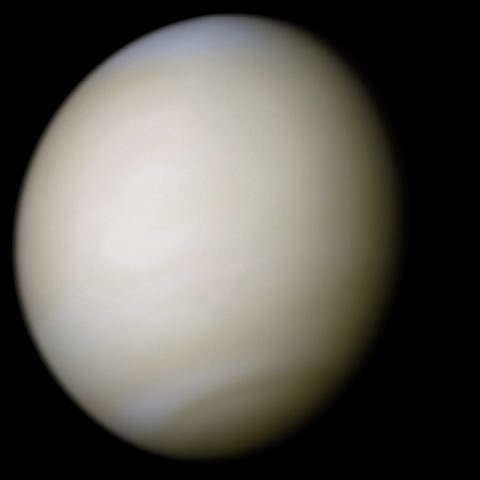Current Info for Observer
as of 05/02/2024 2:37 a.m.
Please login to view current observation details
General Info
as of 05/02/2024 2:37 a.m.
| Type | Planet |
| Constellation | Aries |
| Magnitude | -3.80 |
| Orbits | Sun |
| Right ascension | 2:05:44.62 (Hours) |
| Declination | 11:27:52.0 (Deg) |
| % illuminated | 98.797 |
| Distance from Earth | 1.70301AU |
| Distance from Sun | 0.72509AU |
| Elongation | -9:01:48.3 |
| Mass | 0.815 ⊕ |
The second planet | |
☉ Solar Masses ⊕ Earth Masses j Jupiter Masses
Naked eye
100 points
Very bright tonight.
8 inch Dobsonian
100 points
Orion XT8
100 points
Orion 10'' SkyQuest dobsonian
100 points
We observed Venus during a camping trip to Joshua Tree National Park. Venus was an evening star shining brightly over the western horizon, which was a beautiful volcanic ridge covered in shrubs and cactus.
The question was raised: "how would you prove the earth is not the center of the universe?" and we discussed the phase of Venus. Turns out it is impossible for Venus to show the full phases that we observe yet have rotating around the earth. Here's a great animation:
We observed Venus and it showed a phase, about 75%. Although that phase could show in a geocentric model, we left it at that.
Jason 304 T 60 mm f/10
100 points
GALILEO PROVOCARE, or An Attempt to Replicate the Findings of the Heretical Natural Philosopher on the Twenty-fourth and Twenty-fifth of March in the Year of Our Lord Two Thousand and Fifteen
This was my first object of observation of the evening, chosen as it was low in the West, and would soon disappear behind the trees surrounding the observing site. It appeared to be of a somewhat yellowish hue, and possessed a somewhat flattened aspect on the side to the east, away from the setted sun. This was only one observation, and several more would be needed to confirm Sr. Galileo’s contention the Venus hath phases like the moon, it must be said that this single apparition gave me pause, as it did resemble the gibbous moon in shape. Most significantly, it was not a perfect sphere. This was the first indication that our knowledge of the heavens does not match what we can see through the instruments of the Dutch lens makers.
Note: An Esteemed Colleague on the site Noctes Nubia, hath issued a Challenge to confirm the findings of Galileo Galilei of Padua. I undertook to accept this Challenge, with the Additional Constraints of 1) completing all the observations in a single night, and 2) using an instrument close to that used by Signor Galileo, rather than the Finer Instruments available to me. Thus I Attempted to make these Observations with a Jason 304-T Telescop, with a 60 mm Primary Lens and a Length of 600 mm. It is still a Superior Instrument to that used by Sr. Galileo; It Must be–it says 200X on the side. I was unable to find its Associated Collection of Eyelenses, but did locate a “18 mm Erecting Eyepiece 14X Micro Scope” which Seemeth to work, though it Requireth the Focuser to be wound all the way out to achieve a Semblance of focus. My Computation Suggests this gives a Magnification of 33X.
I began my Observations at the Smolen Observatory on the Grounds of Universitas Novum Pfalts de Novo Eboracum.
Generate a finder chart
The following form will generate a PDF finder chart suitable for printing using to locate objects in the sky with your telescope!
The Date is only really useful for solar system objects, as deep space objects move measurably only on a galactic timescale.
The larger the F.O.V (field of view), the more "zoomed out" the object will appear. It can be helpful to print several charts of the same object with different field of views.
Limiting the magnitude (remember, lower magnitude means brighter!) of stars and objects can make sure your chart is not cluttered with dim objects that you may not be visible to you anyway. The defaults are good, but try experimenting with raising and lowering the values.
Please login to post comments
